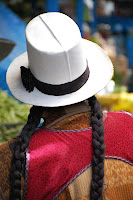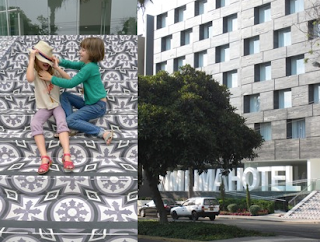 Until we hit the departure gates of Lima airport, Santiago was probably the most modern of the South American airports we'd visited, but also the most chaotic. Lima's by contrast was an oasis of calm on the day we left for Cuzco. I was lucky to find ind "One Hundred Years of Solitude" in the bookstore, and we sourced some excellent chocolate covered coffee beans and cashews for the trip. Before departing, I took no books but loaded up my Kindle, intent on travelling light over two months. It's been handy for digital versions of bulky Lonely Planet guides, a voyage worth of bed-time stories and travel tales.
Until we hit the departure gates of Lima airport, Santiago was probably the most modern of the South American airports we'd visited, but also the most chaotic. Lima's by contrast was an oasis of calm on the day we left for Cuzco. I was lucky to find ind "One Hundred Years of Solitude" in the bookstore, and we sourced some excellent chocolate covered coffee beans and cashews for the trip. Before departing, I took no books but loaded up my Kindle, intent on travelling light over two months. It's been handy for digital versions of bulky Lonely Planet guides, a voyage worth of bed-time stories and travel tales.
However, I also left plenty of space for the Latin American novels I planned to download, hopping from one WiFi spot to another, as soon as Joseph Conrad's "Nostromo" was behind me.
It's been a disappointment to learn that practically none of the South American greats are available electronically, save for original language versions of certain titles. Forget about anything vagely obscure.
So I was thrilled to find "The Insufferable Gaucho" in the library of Tierra Patagonia, a collection of stories and articles by Chilean Roberto Bolano. And on this occasion Gabriel Garcia Marquez' masterwork, a fine prelude to our visit his native Colombia. Like Conrad's Sulaco, Marquez' Macondo is an entirely fictional place. The first few pages are evidence enough of Marquez' magic realism, to contrast the very historical realism that Conrad aims at in his book.
But enough of fiction, back to reality... The transition from Lima's coastal plain to the Andean heights is rapid. The approach to Cuzco is remarkably green, but rough and rugged and vertical. Here rivers have carved ravines, and not the flood pains that became a familiar sight (duly flooded) around Cachi, in the Valle de los Calchaquies. No wonder the native Quechua managed to hide the existence of Machu Pichu from Spanish Conquistadores, and for it to remain "forgotten" into the 20th century.

Already at school I'd identified more with Indians than Cowboys in the inevitable schoolyard games (do kids in the States still play at that? Or is it all re-enactments Halo and GTA these days?). What with their dazzling head-dresses, their warpaint, hunting prowess and decorated horses. Why would anyone want to dress in the drab costume of cowboys, whatever the firepower of their Colt 45's? But my first notion of injustice came with the stark illustrations in a childhood issue of National Geographic that chronicled the demise of the Incan empire. The pictures are still vivid in my mind. Pizzaro and his small band of well-armed men banishing Atuahalpa and his Inca warriors to slavery and stealing their gold.
It's an episode related on several dimensions by Jared Diamond in his excellent "Guns, Germs, and Steel". Just the way of the world, one might say. But somehow remarkable that indigenous people and mestizos alike should have reconciled themselves to an historic calamity of such proportions. The Inca trail, the extent of the political and economic organization, of a staggering scope and advancement... That said, can Machu Pichu possibly live up to all the hype of being one of the Seven Wonders of the World?
 Cuzco was underwhelming, and its outskirts are dispiriting. And yet, the women walk proud in their dayglo colours and hats!
Cuzco was underwhelming, and its outskirts are dispiriting. And yet, the women walk proud in their dayglo colours and hats! 















































